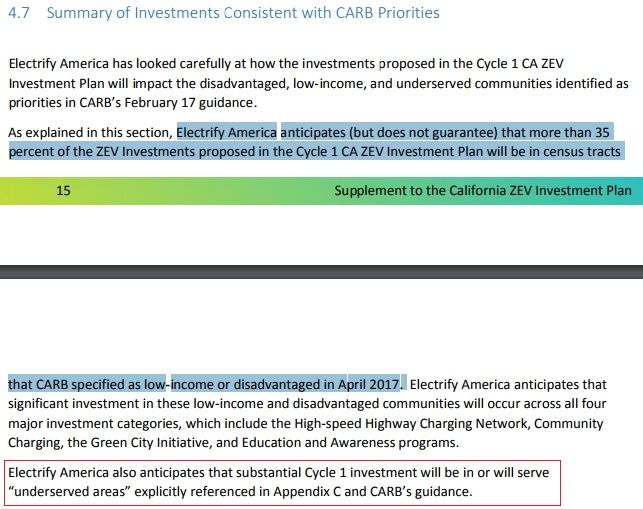Once again, our good friend
@McRat is spewing mis-information in an ongoing campaign to discredit anything and everything being done by CARB, VW and the State of California. Please see subsequent and more accurate posts from poster
@Jeff N for a clearer picture of what the CARB approval means.
I'll take this opportunity to show why McRat is incorrect...
Here is the exact wording from the supplemental plan that CARB is going to approve Thursday. In the quote below, you see how VW states that their spending does not need to go to disadvantaged communities:
So no, the VW spending earmarked for "Community Charging", which is $89 million total, does not need to be spent in "disadvantaged" communities.
If you actually read the Supplemental Plan, you will see that there is a BIG difference between the two concepts of "disadvantaged communities" and "underserved communities". The former has a lot to do with income, but the latter has nothing to do with income. Underserved is based on to what extent the projected number of EVs sold in a given area exceeds the current number of chargers available in that area. That is the criteria VW will be using for the placement of the community chargers. Here is where that is described in the Supplemental Plan:
VW later goes on to describe how they will include census tracts from low income communities in a "significant percentage" of their community charging deployments:
And section 4.7 sums it up nicely, where they discuss: 1) underserved, 2) disadvantaged, and 3) low income communities, and state that 35% of the community investments may very well end up in disadvantaged communities, but that they do not guarantee this...
I would encourage everyone participating in the thread to read through both the original and supplemental plans before pulling out the pitchforks based on uninformed and incorrect inflammatory posts meant only to discredit all parties involved in the process.
It is not in VWs best interest, as an EV producer, to intentionally waste this huge amount of money, when they will be one of the beneficiaries of it by being able to sell more EVs. It is not in CARB's best interest to force VW to spend money deploying infrastructure that would not be as useful as possible, both now and into the foreseeable future. This is precisely why CARB is going to approve the VW spending plan on Thursday (7-27-17), and we can get back on track to getting chargers installed and used.
And BTW, there will be $75 million spent on DC fast charging deployment, with 50+ stations averaging 5 plugs each. The above discussion was primarily concerning the $89 million allocated for community charging, which will be 350+ locations and 2,000 chargers.
In summary:
$89 million community charging
$75 million DC fast charging
$20 million for education
$16 million for ride and drive events and operations
--------------------------------------------------------------------
$200 million first 30-month period
Back to reality now...
RT







